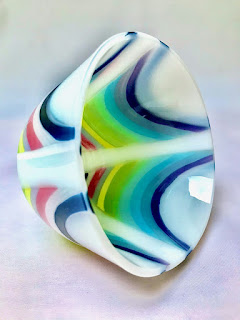 |
| credit: timeanddate.com |
 |
| Credit: Shutterstock |
“What are the pros and cons on turning up the max temperature slightly Vs. a longer hold time”? Lea Madsen
This is a difficult question
to answer, because there are variables such as
the temperature range,
the ramp rates, and soaks,
the forces acting upon the glass at a given temperature,
the process,
the desired outcome of the firing,
etc.
When talking about temperature vs. time, it is heat work
that we are considering. In many processes
time and temperature are interchangeable, although the temperature range is
important too. This is a brief
discussion of heat work in various processes.
Slumps
Slumping
temperature is generally in the range of 620˚C-680˚C/1150˚F -1255˚F *, which is
below the devitrification range. This
allows the exchange of time for temperature without risk, allowing more time
rather than more temperature. Higher temperatures cause more marking from
the mould since the bottom of the glass is softer than at lower ones. Lower temperatures give higher viscosity, so
the glass is stiffer, resisting marks.
Low temperature fuses
Sharp tack fusing, freeze and fuse, some pate de verre
processes, and sintering occur in the 650˚C
-720˚C /1150˚F - 1320˚F range, risking devitrification only at the upper end of this
range. Extending the time rather than
the temperature is important to maintain detail in these processes. Higher temperatures will smooth the surface, risking
loss of detail.
Rounded tack processes (720˚C – 760˚C /1320˚F - 1400˚F)
These are within the devitrification range making the
choice between time and temperature a balance of risks. In my experience, it takes about an hour for
visible devitrification to develop. This
means that you can extend the time, if the total time between the end of the bubble
squeeze and the working temperature, including the hold time, is less than an
hour. It has the advantage of a more
secure attachment between the pieces of glass, without altering the surface
much.
But if extending the soak time increases the time in the
devitrification zone to be more than an hour, it is advisable to increase the
temperature, rather than time. Devitrification
develops in the presence of air, so reducing the time in that range reduces the
risk of devitrification developing. The
glass is moving during rapid ramp rates, reducing the chance of devitrification.
Drops
This includes drapes, and other free forming processes. Kilnformers will be observing the progress of
these firings, making it easier to balance temperature and time. There are already long holds scheduled for
the processes, so it is a matter of getting the right temperature. If, after half an hour at the scheduled top
temperature, the glass has not moved much, it is time to increase the
temperature by, say 10˚C/18˚F and observe after another half hour, repeating the temperature increase if
necessary. Be aware of thinning the
glass at the shoulder by setting a high temperature. Free drops may take as much as 6 – 8 hours,
so patience and observation are important to get good results.
Full fuse
At full fuse try to
get the work done in 10 minutes to avoid complications with
devitrification. So, increasing the
temperature rather than the length of the soak seems best.
Flows
Whether frit stretching, making pattern bars, pressing, etc.,
low viscosity is important. Viscosity is
closely related to temperature, so increasing the temperature is the better
choice. Increasing time without
increasing temperature does not change viscosity much.
Casting
Extending time at top temperature seems
best for open face casting, as the temperature is already high. A slow ramp rate to that top temperature may make
adding time unnecessary, because the heat work will be increased by the slow
rise. Experience has shown that a rate
of 200˚C/360˚F is enough to avoid devitrification. With enclosed castings devitrification is not
such a risk, so time can be added without concern.
Observation
In all these processes it is advisable to observe
the progress of the firing by quick peeks to determine the effective
combination of temperature and time.
Also note that heat work is
cumulative, making for changes in profile with repeated
firings.
* The softening point of float glass is around 720°C/1328°F, so
the slumping range is about 700°C/1292° to
750°C/1382°F.
















